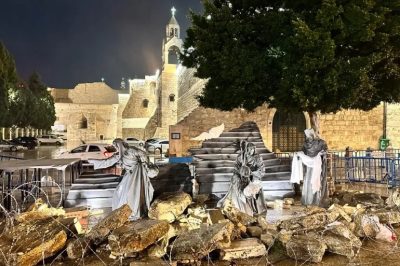Bethlehem’s Bombed-out Nativity Sculpture Sends a Powerful Message
The scene of a devastated nativity cave symbolises the plight of Christ’s family — and Palestinians now.

All Global Research articles can be read in 51 languages by activating the Translate Website button below the author’s name (only available in desktop version).
To receive Global Research’s Daily Newsletter (selected articles), click here.
Click the share button above to email/forward this article to your friends and colleagues. Follow us on Instagram and Twitter and subscribe to our Telegram Channel. Feel free to repost and share widely Global Research articles.
***
This year, Bethlehem is sombre and quiet. There is no Christmas tree and there are no holiday lights or tourists to see them.
Instead, the city of Jesus’s birth – which is in the middle of a war zone – is marking Christmas with a powerful and poignant message: solidarity with Palestine.
The Holy Family Cave is a sculpture that depicts a harrowing tableau: a bombed-out version of the traditional nativity cave, which many Christians traditionally believe is where Jesus was born in Bethlehem. It is the site now of the Church of the Nativity in Bethlehem.
The new mural draws a comparison with the journey of Christ and his family, when they had to flee Bethlehem under an oppressive ruler to Egypt, before returning to Nazareth two millennia ago.
![[Monjed Jadou/Al Jazeera]](https://www.aljazeera.com/wp-content/uploads/2023/12/Bethlehem-Holy-Cave-image_image_64834411-1703371430.jpg?w=770&resize=770%2C514&quality=80)
The bombed-out nativity scene is surrounded by rubble and barbed wire [Monjed Jadou/Al Jazeera]
Surrounded by rubble and barbed wire, the Virgin Mary embraces the baby Jesus, while Joseph embraces her, offering solace. On one side of the family, the Magi holds out a white shroud. On the other side, the fourth shepherd carries a bag, a symbol of Palestinian displacement.
Angels, suspended around the rubble, represent the souls of children who have been victims of massacres on Palestinian land throughout history: the murder of children in Bethlehem by Herod at the birth of Jesus; various colonial attacks against the Palestinian people and their ancestors; and current massacres by Israel in Gaza.
Around the scene, multilingual panels call for a ceasefire and an end to the massacre against the Palestinian people.
Hana Hanania, the mayor of Bethlehem, said the sculpture aims to showcase Palestinian suffering everywhere. Churches, clergy and civilians in Gaza are being bombarded, and a blockade is enforced in the West Bank, particularly in Bethlehem.
![[Monjed Jadou/Al Jazeera]](https://www.aljazeera.com/wp-content/uploads/2023/12/Bethlehem-Holy-Cave-image_image_64834415-1703371458.jpg?w=770&resize=770%2C514&quality=80)
The fourth shepherd carries a bag, symbolising Palestinian displacement [Monjed Jadou/Al Jazeera]
The sculpture, with its political, religious, and national symbolism, draws a comparison between what happened more than 2,000 years ago and what is happening today, she said. Just as Christ was tortured and children were killed by King Herod then, today, children and women are being slaughtered in a clear act of genocide.
The cave’s roof is a geographical map of Gaza. Its shape, together with a depiction of an explosion, form a star, inspired by the Star of Bethlehem that led the Magi to Jesus’s birth. This conveys a message of hope.
The artist, Tarek Salsaa, explained that the scene cannot fully express the immense destruction and systematic genocide against the Palestinian people by the Israeli occupation. What Palestine is going through today is reminiscent of the years of colonialism, with all its allies throughout the ages and various historical epochs, he added.
“Christmas approaches this year, and we find ourselves living in the most challenging and difficult circumstances, a result of what our people in the besieged Gaza Strip and in all cities, villages, and camps of the West Bank and Jerusalem are enduring due to the Israeli continuous aggression against our people, said Rula Maayaa, the Palestinian Authority’s minister of tourism and antiquities.
“As we launch this symbolic initiative in Bethlehem … our people are confident that the message of Christmas, sent by the messenger of peace, will triumph over injustice and tyranny,” Maayaa said.
![[Monjed Jadou/Al Jazeera]](https://www.aljazeera.com/wp-content/uploads/2023/12/Bethlehem-Holy-Cave-image_image_64834416-1703371464.jpg?w=770&resize=770%2C514&quality=80)
People light candles near the installation [Monjed Jadou/Al Jazeera]
We are in a constant state of mourning, especially during the days of mourning for the martyrs, said Father Ibrahim Feltz, the deputy custodian of the Holy Lands. “We have not witnessed such a scene in the square, and we have not seen the city in this condition. Bethlehem has never been sad like this before.”
*
Note to readers: Please click the share button above. Follow us on Instagram and Twitter and subscribe to our Telegram Channel. Feel free to repost and share widely Global Research articles.
Featured image: A bombed-out version of the traditional nativity cave in Gaza is a symbolic comparison to the first family of Christ [Monjed Jadou/Al Jazeera]

